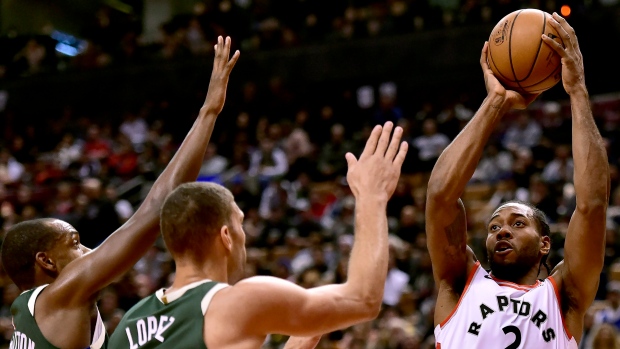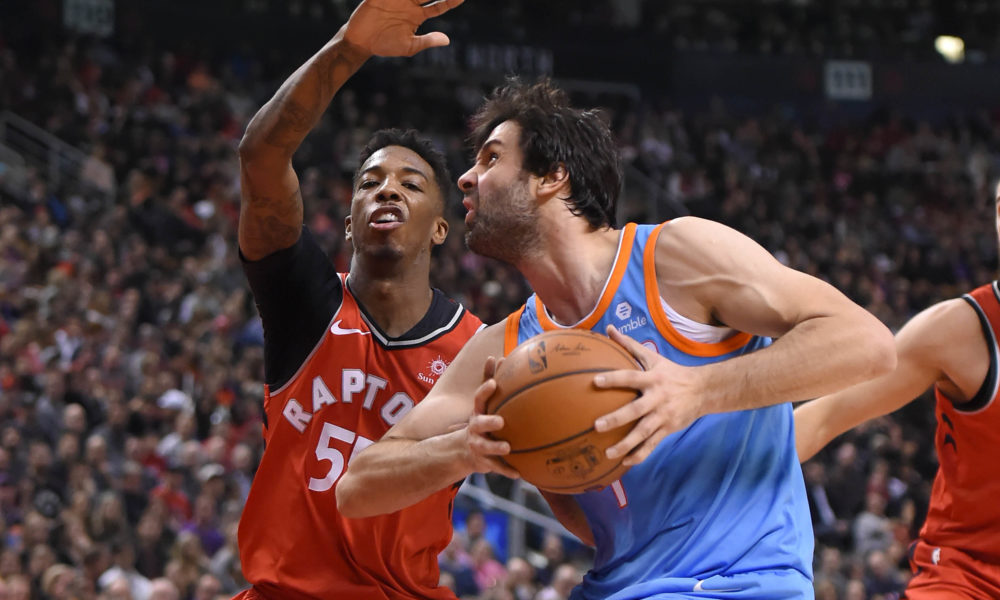Bucks 104, Raptors 99
Recap
- Both teams came into the game with a good scout and executed their game plans well. However, defensive breakdowns in the second half ultimately cost the Raptors in the end.
- The Raptors changed up their defensive philosophy and switched all actions (excluding actions that involved JV) and found good success with it. As a result of the switches, they often had guards covering Giannis in the post and therefore effectively brought double teams to get the ball out of his hands.
- Similarly to the first game, the Bucks defended the ball screen by dropping their big and not rotating their guards – essentially making all ball screens 2-on-2 situations – and dared Ibaka and JV to beat them. Just like the first game, Ibaka led the Raptors in FGA with 21 shots, and was 4-11 from the 3.
- The Raptors broke down in 2 areas in the second half defensively which was the difference in the game:
- Transition Defense
- Defending the Milwaukee guards off the dribble
- For the Raptors to win meaningful games against elite teams, their best players will need to be their best players, and they weren’t in this case. Kyle Lowry was extremely pedestrian throughout the game.
Raptors’ Game Plan
- The Raptors struggled against the Bucks in the first match-up, and have struggled against teams all year covering off-ball screens. By chasing all screens (which they have been doing), they have had issues with giving up easy paint touches to curling guards, which has compromised their defense.
- Further to that point, and likely the reason they made an adjustment going into this game, is that when asking their guards to chase and force the curl towards the rim they must also keep the defender guarding the screener (usually the 5) in the paint to protect against the curl. However, the Bucks’ personnel doesn’t allow that because Lopez is a threat to shoot the 3, and too much separation between him and the 5 could be easily exploited.
- The adjustment the Raptors made was to switch all actions, both off-ball and ball screens, unless JV was involved.
What you’ll notice in these clips is the difference from every Raptors game so far – they are switching everything. The change in philosophy forced the Bucks to rely on beating the Raptors with match-ups in the half court, as opposed to giving them more opportunities to beat them with actions that lead to advantage situations. While the strategy was effective, it wasn’t perfect. You’ll notice one clip in the video above where VanVleet is switched onto Giannis and can’t do much about a lob passed to him.
- The major issue with switching everything against the Bucks is that Giannis is going to get matched up with guards in the post. The Raptors were well prepared for this and doubled the post all game long to get the ball out of Giannis’ hands:
When the Raptors switched small guards onto Giannis, the Bucks went after the match-up immediately. The Raptors did a very good job of working hard to not let the ball into the post, and when it did, they waited until Giannis made his initial move before the double team attacked. This limited his vision and prevented him (for the most part) from making direct passes for open 3s.
Bucks’ Game Plan
- The Bucks, like in the first game, decided that they wanted Ibaka to be the player that would have to beat them. In the half court, Lopez provided the help in the paint and often abandoned Ibaka on the perimeter to do so. Similarly in the ball screen, the Bucks dropped the big and didn’t rotate any of the guards, essentially forcing Ibaka and JV to beat them either on the pop or on the window catch.
You’ll notice in these clips that both in the ball screen, and on other actions in the half court, Lopez is protecting the rim first and acting as a helper instead of worrying about Ibaka on the 3.
- The issue here for the Raptors is not that Ibaka is incapable of making these shots – he is – but he is a much better shooter from inside the arc than he is outside of it (54.8% compared to 29.2%). Watch the difference when he catches in the window, or attacks the rim on the catch:
Apart from the realization that Ibaka is a more effective scorer inside the 3 point line than outside of it, you’ll also notice in these clips that by catching inside the 3, he forces the Bucks to rotate to him which then leads to passing options to better 3-point shooters.
- As you likely have noticed, and I have mentioned before in previous breakdowns, Ibaka wants to be a 3pt shooter. The Bucks bet on the fact that, more often than not, he would succumb to the temptation of shooting 3s instead of making plays inside the arc, and they were right.
- Given that Ibaka is shooting the 7th best 3PT % on the Raptors (excluding the injured Powell who is shooting 40.9%, and CJ Miles who is a better shooter but shooting a lower %), 11 3PT attempts in a single game is not a recipe for success.
Raptors’ Breakdowns
Transition
- In the 3rd quarter, the Raptors really struggled to control the Bucks in transition and allowed them to create easy scores. The Raptors were doing a good job of limiting opportunities and advantage situations in the half court, but they spoiled a good defensive performance with their lack of communication and effort to stop the ball in transition during the 3rd quarter:
High-level defensive transition is more complicated than one might imagine, but the first rule of any defensive transition is simple – stop the ball. Notice in these clips how continuously the Raptors are unable to stop the initial penetration. The more concerning part for me is that in almost every situation, the Raptors have the numbers advantage. What I mean by this is that, more often than not, there are more Raptors’ players back on defense than there are Bucks players on offense. When that is the case, extra defenders can drastically impact the play by helping slow down the ball handler. That doesn’t happen in any of these clips.
- The poor defensive transition of the 3rd quarter reappeared at the worst possible time – as the Bucks won the game on this transition sequence:
For as great of a defensive player that Kawhi Leonard is, this lack of effort in defensive transition cannot happen. After a turnover, he not only doesn’t sprint back but he barely attempts to close-out and contain Bledsoe in the corner, which leads to a wide open game-winning 3.
Covering the Bucks’ Guards
- In the first game these teams met, Brogdon and Bledsoe absolutely destroyed Lowry and VanVleet on the perimeter. They used their size advantage to bully them and create great opportunities for their teammates continuously throughout that game. In the second half, the Raptors’ guards (mainly VanVleet) were again unable to contain the Bucks’ guards, and they scored a handful of points in a much too easy fashion:
This is not a flattering video for the Raptors’ guards – especially VanVleet. They simply could not stay in front on too many occasions which, like their transition D in the 3rd quarter, compromised their half-court defense and ruined an otherwise well played defensive game.
Notes:
- Lowry’s poor performance against the Bucks is something to be slightly concerned of. He will shoot the ball better – I have no doubt about that – but I worry that Brogdon, Bledsoe and Middleton have gotten into his head. They cause him all sorts of problems offensively, as their length and size make it difficult for him to create, and defensively they look excited to attack him in both games. With the Bucks being a team that the Raptors will likely have to beat to get out of the East, and Lowry being the engine that makes the Raptors go, this narrative will need to change in order for the Raptors to be successful.




